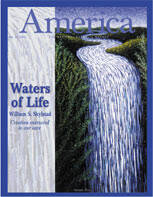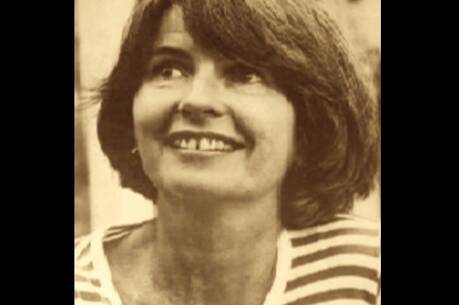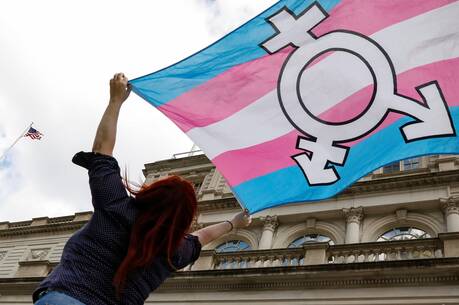Throughout Scripture we encounter references to flowing water and its power to renew life. John baptized Jesus in the waters of the River Jordan, where Jesus began his own public ministry. In John’s Gospel, Jesus meets the Samaritan woman at a well. He tells her of the life-giving (flowing) water he offers. And from the time of the Apostles, the waters of baptism connected people in the body of Christ.
The Columbia Watershed
Rivers throughout the world demonstrate the connectedness of creation. They flow from mountains, pass through all kinds of terrain and empty into the world’s oceans. One of the world’s great rivers is the Columbia, immortalized in Woody Guthrie’s song “Roll On, Columbia.” The Columbia is an international river, flowing through southwestern Canada and the northwestern United States. From the snow-capped peaks of British Columbia it winds through the desert country on the eastern slopes of the Cascades and finally on to the majestic Pacific. Just as it reflects the interconnectedness of creation, the Columbia reminds us of the interconnectedness of the human family.
That human interconnectedness is nearly as complex as the ecosystems through which the river flows on its journey to the sea. For the native peoples of the region, the Columbia is the vibrant and living entity from which they have drawn their sustenance since before the dawn of history. It is the migration route of salmon traveling to and from the Pacific. The Columbia is also a highway that supports commerce through its voluminous barge traffic. Its many dams are a source of electrical energy, vital to homes and businesses across much of the continent. The river also provides water for a vast system of irrigation that transformed agriculture in central Washington.
The fact that the Columbia flows through two nations adds an international dimension. Through an international agreement, the upper part of the Columbia in British Columbia consists of large reservoirs for the storage of water for later release, and serves as a holding area during dangerous flooding conditions.
The Columbia’s complex uses often pit one faction of the population against another. The Hanford nuclear reservation, site of plutonium production during the Second World War, is a source of contention. Hanford is now one of the most contaminated areas in the United States from which radioactive material has seeped through the ground and into the industrial and agricultural water table. Other pollutants flow into the river, and the damage is not easily or cheaply remedied.
Free-flowing water is necessary for salmon migration to and from the ocean. Yet the completion of Grand Coulee Dam in the early 1940’s stopped the migration of these fish to the upper reaches of the Columbia and had an adverse impact on the culture of the native peoples, who depended heavily on the salmon for food.
Today efforts aimed to restore declining fish populations compete with efforts to meet the needs of agriculture. There has been a movement to breach the dams on the lower Snake River, an important tributary to the Columbia, for the sake of fish migration. But wheat farmers throughout the Columbia watershed rely on the barge system that transports grain to ports like Portland, Ore. If the dams are removed, barge traffic on the lower Snake River will be an impossibility. So, as much as the Columbia River unites people across borders and ecosystems, competition for its use has the potential to divide them.
The Response
In the late 1990’s, the Catholic bishops of the eight dioceses in the Columbia River watershed, seven in the United States and one in Canada, decided to prepare a pastoral letter reflecting on the Columbia River system. Our “awakening” to the theological significance of the Columbia River is part of a new consciousness in the whole church. Pope John Paul II’s message for the 1990 World Day of Peace, titled The Ecological Crises: A Common Responsibility, had already highlighted the importance of the environment for the Catholic community. The U.S. Catholic bishops’ pastoral letter in 1991, Renewing the Earth, and the Canadian Catholic bishops’ statement of 1996, The Environmental Crises: The Place of the Human Being in the Cosmos, offered Catholic visions of ecology and identified the potential contribution of the Catholic community to public responsibility for nature. Over the last two decades the principle of caring for God’s creation has become recognized as a constitutive element of Catholic social teaching.
With the assistance of grants from the U.S. Catholic Conference’s environmental justice program and the National Religious Partnership for the Environment, bishops from the eight dioceses began work in 1997 on the Columbia River pastoral letter project. “We write this pastoral letter,” we said, “because we have become concerned about regional economic and ecological conditions and conflicts over them in the watershed. We hope that we might work together to develop and implement an integrated spiritual, social, ecological vision for our watershed home, a vision that promotes justice for people and stewardship of creation.”
Consultation
Early on we bishops decided that the pastoral letter should be positive, informative, reflective and grounded in the church’s tradition. It would offer guiding principles for the ongoing dialogue about the Columbia’s place in our culture rather than specific solutions for the future.
To ensure that our pastoral letter adequately mirrored the Columbia’s rich diversity, a steering committee was appointed consisting of 18 representatives from the eight dioceses in the watershed. We began, in the spirit of the Second Vatican Council, with a series of listening sessions conducted across the region to help us “read the signs of the times” as they related to the Columbia. People of diverse backgrounds and viewpoints were invited to these gatherings, and the Catholic universities of the Northwest were involved as well. In every session, although very different viewpoints were expressed, there was always a sense of respect for one another.
The Canadian farmers from the upper reaches of the Columbia voiced hurt and anger about being displaced when their farms were used as part of the reservoir system to control flooding. Native peoples have long felt the same kind of hurt and anger about the changes forced upon their culture. Some of them were removed from their homes with as little as two days notice to make room for the Hanford nuclear reservation.
Tension between farmers and those supporting the breaching of the dams on the lower Snake River was also evident. Because of the very poor salmon runs, the advocates of dam-removal put considerable pressure upon bishops to support breaching the dams. We chose not to do so. Recently scientists are recognizing that the conditions in the ocean—for example, water temperature—greatly influence the availability of food for salmon and therefore their numbers. So preserving salmon habitat requires a more comprehensive approach than simple dam removal. Despite these tensions, the bishops’ hearings connected people and contributed to dialogue. Consistently participants reported they felt they had been heard.
As we began our process, I thought I knew the Columbia intimately. I grew up on one of the river’s tributaries, the Methow River in north central Washington. The river bordered my family’s apple farm. Even as a young boy, the connectedness provided by the river was apparent. One day I asked my mother for a bottle with a cork in it. I put a note in it, threw it in the river and fantasized that I might sometime in the future hear from someone in faraway Japan or China. Even though I never received a response, my appreciation of the Columbia was magnified by the sense that my message had connected me with the world beyond my valley. But as well as I knew the river, our listening sessions led me to an even greater awareness of the Columbia’s significance.
The Pastoral Letter
A steering committee developed an initial draft of the pastoral, which was then reviewed by the bishops. After reviewing the draft and receiving information from the listening sessions, we bishops prepared a series of revised drafts. Between drafts we continued our consultation with people throughout the region.
The final document was divided into four parts. “The River of Our Moment” analyzed current conditions along the river; “The River Through Our Memory” reflected on the social and religious history of the Columbia basin; “The River of Our Vision” tried to imagine an alternative future for the watershed; and finally, “The River of Our Responsibility” laid out an ethic of stewardship for the river, its peoples and ecosystems.
The letter’s underlying theology was creation-centered. “The Columbia and all creation,” we wrote, “are entrusted to our care.” It is “the common home and habitat of God’s creatures, a source for human livelihood, and a setting for human community.” In keeping with Catholic teaching on the divine purpose of created things, we stressed, the abundance of the Columbia Basin, our common home, must be equitably shared. “The reign of God proclaimed by Jesus,” we wrote, is “evident in people’s efforts to restore God’s creation and to live in harmony with the earth and all creatures, and in struggles to promote justice in human communities.”
In the concluding section, we outlined nine specific considerations for taking care of the river with respect for the common good. These included conservation of the watershed, protection of wild species, respect for indigenous people and justice for the poor. We also gave considerable thought to integrated, community-based resolution of economic and ecological issues and to promoting social and ecological responsibility in the mining, lumbering and farming sectors.
Implementation
Rivers speak to us of many things. In our Catholic tradition they speak to us of the wonder of God’s creation and our responsibility to be faithful children of that loving God. Recognizing this, The Columbia River Watershed: Caring for Creation and the Common Good was issued on Jan. 8, 2001, the feast of the Baptism of the Lord. The date reaffirmed the ongoing gift of our own baptism. [The pastoral letter is available online at www.columbiariver.org. Copies of the pastoral letter, study guide and video are available through the Washington State Catholic Conference at wscc@thewscc.org or (206) 301-0556.]
As we developed the pastoral letter, our goal was a document that could be easily understood. We also sought to make the document and its accompanying materials reflect the beauty of the Columbia. Many pictures of the river enliven the final document, and the video produced as part of the implementation effort is a beautiful and captivating testimony to the river’s majestic place in our culture. As is the case with many pastoral letters on issues of social significance, the statement was addressed not only to Catholics but to all people of good will. We hoped to deepen the sense of solidarity among the people of the watershed region.
Our pastoral letter is a living document that has been implemented in many ways throughout our region and across the world. Representatives from the seven U.S. dioceses in the watershed have met to address environmental sustainability issues that need to be considered when parishes renovate or develop new buildings. Efforts are underway to implement an annual gathering of the Catholic bishops of the region with the tribal leaders from the watershed. Catholic Conference staff members have met with state legislators to discuss the implications of the issues raised in the pastoral letter on state water policies. Presentations have been given in three dioceses at annual teacher in-service days, and an integrated curriculum for eighth graders has been developed, inspired in large part by the pastoral letter.
We bishops were clear that we are not experts in matters relating to the Columbia River. We know all too well, though, that God’s marvelous creation is far too often taken for granted. We hope that this collaborative effort will continue to help support the common good, increase mutual respect for all participants and deepen appreciation for the wondrous complexity of God’s creation.
Since the publication of the pastoral, noted scientists have expressed appreciation for the document’s call to preserve the natural environment. In November 2000 the World Wide Fund for Nature and the Alliance of Religions and Conservation honored the Columbia River pastoral letter project with an international award presented at ceremonies in Bhaktapur, Nepal.
At the conclusion of the pastoral letter, we offered these words of encouragement: “People live in the world of nature, not apart from it...we can live in greater harmony with our surroundings if we strive to become more aware of our connection to, our responsibility for, the creation that surrounds us.”
How wonderful is God’s kingdom of creation, of which we are blessed to be a part. And how great is our responsibility as God’s people to care for that creation!








